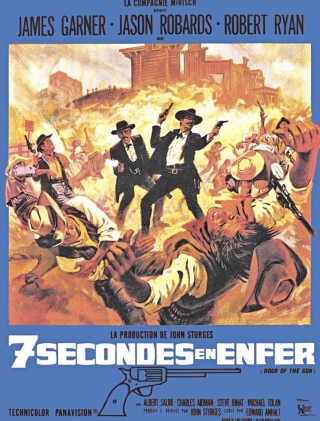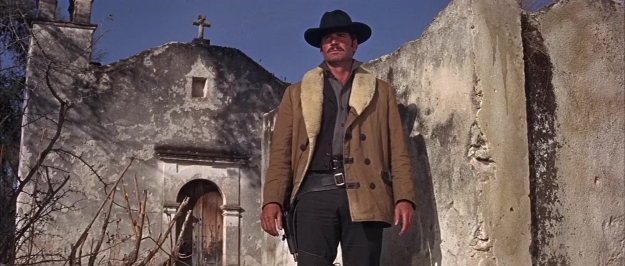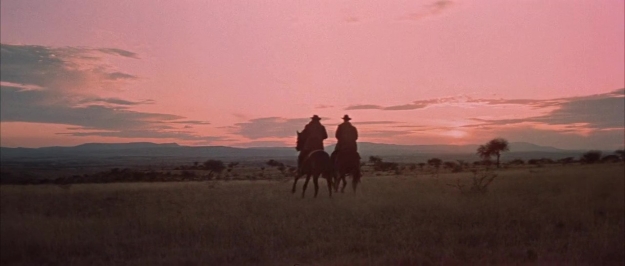
The Hollywood western in the mid-60s was at a crossroads. Television had effectively saturated the market with oaters and the whole genre was becoming filled with cliches. In Europe, the spaghetti westerns of directors like Leone and Corbucci were posing other challenges by taking a new approach to genre conventions and increasing the levels of violence. The dilemma faced by Hollywood was whether it should stick with the traditional formula or borrow from the Europeans. The initial result was a kind of compromise or halfway house. Ralph Nelson will be best known for his brutal cavalry western Soldier Blue; in a way it’s slightly ironic for a man who really only dabbled in the genre. Soldier Blue isn’t all that good a film, and much of its fame derives from the revisionist depiction of the violent excesses of the US cavalry. However, a few years earlier, Nelson made his first western, Duel at Diablo (1966), which offered a similarly bloodthirsty view of the Apache. Taken together, it could be said that the two films balance each other out, although Duel at Diablo is much closer to the traditional western in execution.
The opening of the film gives some indication of what’s to come, as the screen is sliced open by a bloodied knife to reveal a charred corpse suspended over a slow burning fire. From a distance, cavalry scout Jess Remsberg (James Garner) watches and grimaces. Almost immediately, a rider comes into view pursued by two mounted warriors. This is Ellen Grange (Bibi Andersson), a white woman trying to make her way back to the Apache camp from which she has recently been rescued. The film is essentially an examination of race relations within the framework of the conventional revenge western. It is later revealed that Mrs. Grange bore a son while a captive, and this is a large part of her desire to return. However, that’s not her only reason; her husband Will (Dennis Weaver) cannot bring himself to come to terms with what has happened and rejects her. In her husband’s opinion, any decent woman would have killed herself rather than relinquish her honour. The attitude is widespread and is highlighted when Remsberg has to step in and save her as she is assaulted by a group of men convinced of her easy virtue. Remsberg is the only person to show any real compassion towards Mrs. Grange, and that’s because he too has placed himself on the fringes of white society. The second plot thread running through the movie concerns Remsberg’s quest to hunt down the man responsible for the murder, and subsequent scalping, of his Indian wife. While, eventually, the two threads merge and a measure of closure is achieved, the racial issue remains unresolved and the future awaiting both Remsberg and Mrs. Grange is far from certain.
James Garner may not be everyone’s first choice to play a hardened army scout but he acquits himself well. If anyone doubts his ability to play tough and gritty western characters I can only suggest they check out his performance a few years later in John Sturges’ Hour of the Gun. In truth, the casting in general is a little unorthodox, but it works for the most part. The exception would be Sidney Poitier’s dandified ex-soldier, who appears totally out of his element and never truly convinces. Swedish actress Andersson does well as the woman caught between two worlds and her odd accent actually serves to emphasise both her isolation and the outsider status of her character. Bill Travers was another piece of bold casting as the Scots cavalry lieutenant who dreams of promotion. Again I had no real problem with this since it seemed to blend into the overall scheme of highlighting the racial diversity of frontier life.
Ralph Nelson performs the director’s chores competently enough, even managing a few visually evocative shots of the cavalry column which recalls the great John Ford. His best work, however, is most apparent in the action scenes; the clashes between the cavalry and the Apache are well staged and exciting. He also displays a taste for the gruesome that he would indulge further in Soldier Blue; there are a number of scenes of Apache torture that, though tame by today’s standards, must surely have been regarded as strong stuff at the time. Nevertheless, I don’t believe he had any real feel for the western and fails to draw in the viewer in the way the genre’s masters could. Another problem is the score by Neal Hefti, whose jazzy compositions work extremely well in the context of The Odd Couple and How to Murder Your Wife, but tend to grate a little in a western.
Duel at Diablo comes to DVD from MGM in both R1 and R2. The R2 is a typically ordinary transfer from this company (I’m not sure, but I’d imagine the R1 fares about the same) that’s neither all good nor all bad. On the plus side, the image is anamorphic 1.78:1 and there’s a theatrical trailer available, but it tends to be too soft in places. Even though it’s no classic I’d say the film is well worth a view for the interesting casting and storyline.


